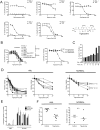Inhibition of mitochondrial translation as a therapeutic strategy for human acute myeloid leukemia
- PMID: 22094260
- PMCID: PMC3221282
- DOI: 10.1016/j.ccr.2011.10.015
Inhibition of mitochondrial translation as a therapeutic strategy for human acute myeloid leukemia
Abstract
To identify FDA-approved agents targeting leukemic cells, we performed a chemical screen on two human leukemic cell lines and identified the antimicrobial tigecycline. A genome-wide screen in yeast identified mitochondrial translation inhibition as the mechanism of tigecycline-mediated lethality. Tigecycline selectively killed leukemia stem and progenitor cells compared to their normal counterparts and also showed antileukemic activity in mouse models of human leukemia. ShRNA-mediated knockdown of EF-Tu mitochondrial translation factor in leukemic cells reproduced the antileukemia activity of tigecycline. These effects were derivative of mitochondrial biogenesis that, together with an increased basal oxygen consumption, proved to be enhanced in AML versus normal hematopoietic cells and were also important for their difference in tigecycline sensitivity.
2011 Elsevier Inc. All rights reserved.
Figures








Comment in
-
Power cut: inhibiting mitochondrial translation to target leukemia.Cancer Cell. 2011 Nov 15;20(5):555-6. doi: 10.1016/j.ccr.2011.10.028. Cancer Cell. 2011. PMID: 22094249
References
-
- Barabé F, Kennedy JA, Hope KJ, Dick JE. Modeling the initiation and progression of human acute leukemia in mice. Science. 2007:600–604. - PubMed
-
- Bonnet D, Dick JE. Human acute myeloid leukemia is organized as a hierarchy that originates from a primitive hematopoietic cell. Nat Med. 1997:730–737. - PubMed
-
- Capps GJ, Samuels DC, Chinnery PF. A model of the nuclear control of mitochondrial DNA replication. J Theor Biol. 2003:565–583. - PubMed
-
- Chrzanowska-Lightowlers ZM, Preiss T, Lightowlers RN. Inhibition of mitochondrial protein synthesis promotes increased stability of nuclear-encoded respiratory gene transcripts. J Biol Chem. 1994:27322–27328. - PubMed
Publication types
MeSH terms
Substances
Grants and funding
LinkOut - more resources
Full Text Sources
Other Literature Sources
Medical

